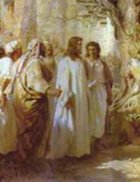The Trinitarian Concept

.... In our previous sections we’ve described the Scriptural basis behind the Doctrine of the Trinity. However, you have may noticed that the doctrine itself is purposely vague in two ways and this is what they are:
.... The Doctrine of the Trinity makes no attempt to define the personal distinctions between the Father, Son and Holy Spirit within the Godhead.
.... Also, it makes no attempt to explain how the Father, Son and Holy Spirit could be distinct personages and yet be one and the same in essence.
.... In other words the Doctrine of the Trinity tells you ‘so’, but not how it is so. There’s not enough revelation in Scripture to set forth a perfect understanding on those points so it is was better not to even try. Think about it and this point will be obvious. It is better to be simple yet basically correct than to press on into deeper things, risk running into errors through human presumption, and embracing those errors as though they were the truth about God Himself. To that extent God would be a ‘man-made’ being, and otherwise than He truly is. So it is better to speak where the Bible speaks and to remain silent where it is silent.
.... Now this vague approach was probably for the best but it did create some problems. Theologians understood why the conclusion had to be reached, but it asked the common people to accept a lot by faith, and basically as an unattainable understanding. So if some couldn’t understand the Trinitarian concept and their faith was not enough, they might reject the conclusion entirely. When this happened, one of two things would result in its place: either polytheism, as we saw in our example with the Colossians, or strict Monotheism, which is the basic intention of the Arians.
.... Therefore, in this lesson, let’s attempt to explain the Trinitarian concept in a comprehensible sort of way. We’re going to keep this study as close to the actual Godhead as possible, and quote Scriptures wherever possible, but please bear in mind that this is simply the discussion of a concept and it is not intend as an actual doctrine. We’re only trying to show the living reality of the Trinity in the sort of way that a person can understand it. So at this point let’s review the Doctrine of the Trinity again:
.... God is One in respect to essence; God is three in respect to personal distinction, and God is three in respect to His roles in the creative and redemptive process.
.... I was talking to a Mormon recently, and they’re a modern group that believes in polytheism. So this Mormon said to me, "If there’s not many gods, what is Genesis 1:26 referring to when it says "Let ‘us’ make man in ‘our’ image, after ‘our’ likeness? Who is this plurality? Who is God speaking of here? Who does God mean by ‘us’?"
.... Once again, the Trinity steals some thunder. Let’s return to Genesis and re-quote the same verse, and in the process add some identifiers. And try to catch the point I’m making by these identifiers:
.... ‘Then God said, "Let us (plural) make man in our (plural) image (singular); after our (plural) likeness (singular)."
(Based on Genesis 1:26)
.... If you’ll take a close look at Genesis 1:26, you’ll see that God is describing Himself simultaneously as both a plural and a singular being: ‘Let us’ which is plural, make man in our ‘likeness’ which is singular. So God is describing Himself as both plural and singular.
.... Now if you’ll look a little closer at that verse, you’ll see that the plural identifiers, ‘us’ and ‘our’, are in reference to personal distinctions, just as the Doctrine of the Trinity would teach; and that the singular identifiers, ‘image’ and ‘likeness’, are in relation to His essence, His being, again as the Doctrine of the Trinity would teach. So actually, Genesis 1:26 is a perfect verse as a proof text for the Doctrine of the Trinity.
.... But the same verse contains an additional clue, and here’s the biggest help that I can give you in understanding the Trinitarian concept itself. In this passage, as God is revealing His own triune nature, He is also saying, ‘Let us make man this way as well.’
.... The Hebrew word for ‘likeness’ literally means ‘manner or similitude’. So when God is saying ‘Let us make man in our image, after our likeness’, He is essentially saying ‘I will make man into a triune being, just as I am.’
.... Now let’s think about this clue. Consider it with me carefully. Is it possible that the triune nature of the Godhead was passed along to mankind in God’s creation of man? Because, remember, God created man in the similitude of Himself. If the Doctrine of the Trinity is true, is there a scale model of the Trinity inherent within man? In Romans 1:20, God talks about revealing His eternal power and Godhead to the world. In the same context, verse 19, Paul tells us that this is because what may be known of God is manifest in us. So is there a scale model of the Trinity within man?
















0 Comments:
Post a Comment
<< Home